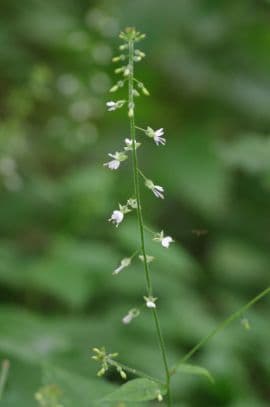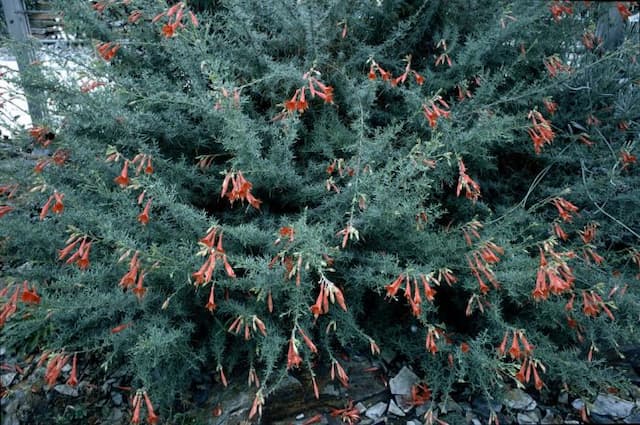Fuchsia 'Star Wars' Fuchsia 'Star Wars'

ABOUT
'Star Wars' is an upright, bushy, deciduous shrub to 70cm tall with ovate, toothed leaves. The small, single flowers borne from summer into autumn have white tubes and sepals and violet-blue petals
About this plant
 Names
NamesFamily
Onagraceae.
Synonyms
Lady's Eardrops, Hummingbird Fuchsia, Hardy Fuchsia.
Common names
Fuchsia 'Star Wars'
 Characteristics
CharacteristicsLife cycle
Perennials
Foliage type
Deciduous
Color of leaves
Green
Flower color
Mixed
Height
2 feet (60 cm)
Spread
2 feet (60 cm)
Plant type
Shrub
Hardiness zones
9
Native area
Central America
Benefits
 General Benefits
General Benefits- Ornamental Appeal: Fuchsia 'Star Wars' offers vibrant and attractive flowers that enhance garden aesthetics.
- Attracts Pollinators: The brightly colored blooms attract hummingbirds and butterflies, promoting pollination.
- Versatility: It can be grown in hanging baskets, containers, or as a bedding plant, offering flexibility in garden design.
- Shade Tolerance: This plant thrives in partial shade, making it suitable for garden spots that do not receive full sunlight.
- Long Blooming Period: It blooms from late spring to fall, providing color in the garden for an extended period.
- Low Maintenance: Requires minimal care beyond regular watering and occasional feeding, making it suitable for novice gardeners.
 Medical Properties
Medical PropertiesThis plant is not used for medical purposes.
 Air-purifying Qualities
Air-purifying QualitiesThis plant is not specifically known for air purifying qualities.
 Other Uses
Other Uses- Fuchsia 'Star Wars' can be used as a natural dye for fabrics and yarns, creating a range of colors depending on the mordant used.
- The plant can be incorporated into sensory gardens due to its vibrant colors and interesting shape, providing visual stimulation.
- Fuchsia flowers can be crystallized and used as edible decorations on cakes and desserts.
- Dried fuchsia flowers can be used in potpourri mixtures to add color and a subtle fragrance to a room.
- Fuchsia plants can be used in art classes or workshops as a subject for botanical illustration, teaching students about plant anatomy.
- The nectar-rich flowers can provide a food source for hummingbird feeders or be placed strategically to attract hummingbirds to a garden.
- These plants can be utilized in fairy gardens, creating a whimsical atmosphere with their hanging blossoms resembling miniature lanterns.
- Fuchsia 'Star Wars' can be used in wedding bouquets and floral arrangements for a pop of color and a touch of the unique.
- Used in photography, the vibrant and contrasting colors of Fuchsia 'Star Wars' can help create striking macro photography images.
- Fuchsia's branches and foliage can be used in the practice of ikebana, the Japanese art of flower arrangement, for their form and texture.
Interesting Facts
 Feng Shui
Feng ShuiThe Fuchsia is not used in Feng Shui practice.
 Zodiac Sign Compitability
Zodiac Sign CompitabilityThe Fuchsia is not used in astrology practice.
 Plant Symbolism
Plant Symbolism- Beauty: The Fuchsia plant is often associated with beauty because of its striking appearance, featuring delicate, teardrop-shaped flowers that come in a vibrant mix of colors.
- Confidence: The bold colors and unusual shape of the flowers can symbolize confidence and individuality, as the plant stands out prominently in any garden.
- Grace: Fuchsia plants have a graceful habit, with flowers that seem to dangle like earrings from the stems, representing poise and elegance.
- Good Taste: The Fuchsia is considered to represent good taste due to its association with sophistication and its selection in ornamental gardening.
- Amiability: With its inviting appearance and charming flowers, the Fuchsia is seen as a symbol of amiability and warmth in relationships.
 Water
WaterFuchsias, including the Fuchsia 'Star Wars', prefer consistent moisture so it's essential to water them when the top inch of soil feels dry. Water thoroughly until excess water drains out of the bottom of the pot, which typically amounts to approximately one to two gallons per week, depending on the size of the plant and environmental conditions. Avoid letting the soil get completely dry, but also be careful not to waterlog the plant as this can lead to root rot. Watering frequency may need to be increased during hot, dry spells or when indoor heating dries the air. During winter, reduce the amount of water, but ensure the plant doesn't completely dry out.
 Light
LightThe ideal lighting condition for a Fuchsia 'Star Wars' is bright, indirect light. They thrive in a location that receives morning sunlight and afternoon shade, or dappled sun throughout the day. Direct, hot afternoon sun can scorch the leaves and flowers, so it's important to protect them during the peak sun hours. A spot with some protection from the midday sun, such as under a tree canopy or on a north-facing porch, would be a preferable location.
 Temperature
TemperatureHardy Fuchsias like 'Star Wars' can generally withstand outdoor temperatures as low as 36 degrees Fahrenheit and as high as 76 degrees Fahrenheit for short periods. However, the ideal temperature range for promoting growth and flowering is between 55 and 70 degrees Fahrenheit. Avoid exposing the plant to temperatures below 36 degrees Fahrenheit for extended periods since frost can damage or kill the plant.
 Pruning
PruningPruning Fuchsias like 'Star Wars' is important to maintain a compact growth habit and promote abundant bloom production. Prune in late winter or early spring before new growth begins. Remove dead or weak branches and shape the plant to your preference. It's also beneficial to pinch out the tips of stems during the growing season to encourage bushiness. Heavy pruning should be done annually, while light pinching can be performed throughout the growing season as needed.
 Cleaning
CleaningAs needed
 Soil
SoilThe best soil mix for Fuchsia 'Star Wars', commonly known as Fuchsia, is well-draining with a high organic matter content. A mixture of peat moss, perlite, and loam creates an ideal environment, with an added slow-release fertilizer to support growth. The soil pH should be slightly acidic to neutral, ranging from 6.0 to 7.0, for optimal nutrient uptake.
 Repotting
RepottingFuchsias, including the Fuchsia 'Star Wars', should be repotted annually to replenish nutrients and provide room for growth. They benefit from repotting in early spring before the start of the new growth cycle or after flowering has completed.
 Humidity & Misting
Humidity & MistingFuchsia 'Star Wars' thrives in moderate to high humidity levels, ideally between 60-70%. It benefits from a humid environment but can tolerate average household humidity levels with occasional misting.
 Suitable locations
Suitable locationsIndoor
Keep in well-lit area, away from direct sunlight, and water regularly.
Outdoor
Plant in partial shade, shelter from strong winds, and keep soil moist.
Hardiness zone
Fuchsia 'Star Wars' is suitable for USDA zones 10-11.
 Life cycle
Life cycleThe life of the Fuchsia 'Star Wars', commonly known as hardy fuchsia, begins with seed germination, which requires moist, well-drained soil and a warm environment. Following germination, the seedling stage is marked by the development of a few sets of true leaves, as the plant establishes its root system. As the fuchsia enters the vegetative stage, it grows rapidly, producing characteristic hanging flowers that attract pollinators and may also be propagated through cuttings at this time. The flowering stage sees the plant producing its distinctive purple and pink blossoms throughout the summer. After pollination, fruits can form which contain seeds for the next generation, although fuchsias are often propagated vegetatively. In regions with cold winters, the plant may enter dormancy, losing its leaves and going temporarily inactive until the return of favorable conditions in spring.
 Propogation
PropogationPropogation time
Spring-Early Summer
The most popular method of propagating Fuchsia 'Star Wars', a plant known for its striking flowers, is through softwood cuttings. This is typically done in the spring when plant growth is vigorous. Gardeners select healthy, non-flowering shoots and make a cut just below a leaf joint or node, so the cutting is about 2 to 4 inches long (5 to 10 cm). The lower leaves are removed, and the base of the cutting is dipped in rooting hormone to encourage root development. The prepared cutting is then inserted into a pot filled with a mixture of peat and perlite, ensuring good contact between the stem and the rooting medium. The pot is then placed in a warm, humid environment with indirect light until roots develop, usually in a few weeks. Once rooted, the cuttings can be transplanted into individual pots and grown on to become mature plants.









